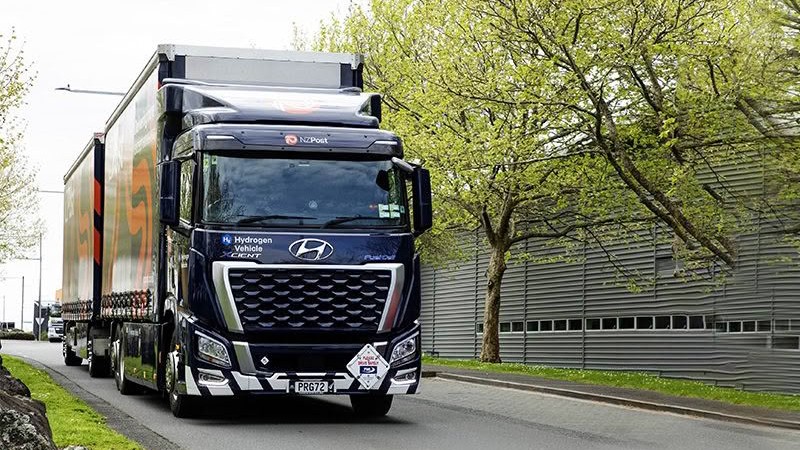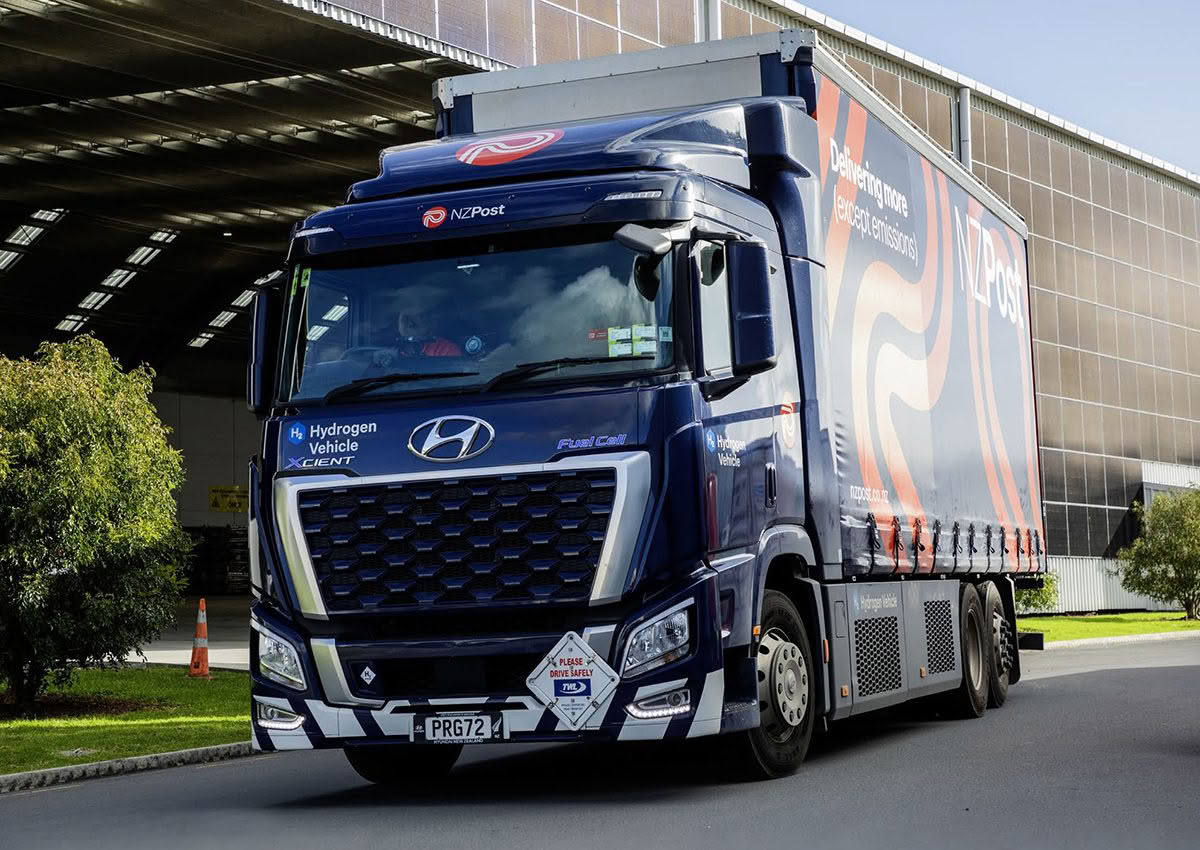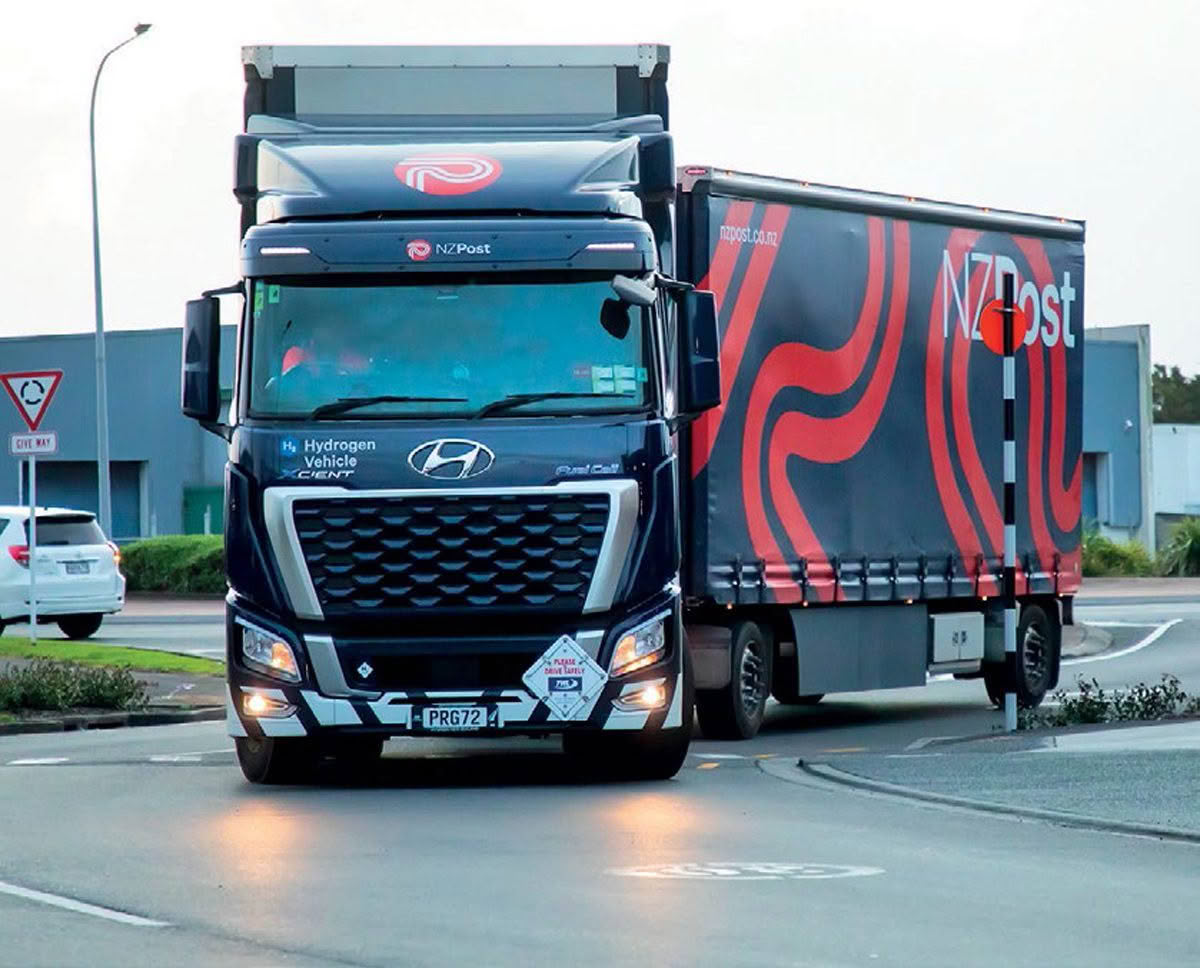
It’s quite amazing to see the number of trucks streaming down Langley Road, Wiri, and into the APC in the early evening. We’d been following the Xcient’s day-shift driver, Dev Narayan, for the past few hours, and now, at about 6pm, we are in the cab with him, sitting in a queue of truck and trailer units coming to collect their evening transfers. As the trucks file in and out and more continually join the queue, the team of forklift drivers shuttle their Maxi bins to the docks and into their respective trucks. It’s one of those scenes that look outwardly chaotic but is, in fact, amazingly slick.
Dev typically runs two loads between the Onehunga Courier Depot (OCD) and APC and two between the South Hub depot and the APC each day before loading up and refuelling for night driver Gurdit Dhillon.
Thirty-five-year-old Dev has been driving for Shea Transport since 2020 and came off a Volvo FH truck and trailer to take over the day shift on the Xcient in May. “It was a different feeling at first; I was so used to driving a diesel. On a diesel, you can feel the revs, the clutch engagement, that something’s happening … In this, you just hit the accelerator. But I’m used to it now; it’s smoother, quieter,” he says with a laugh.


As Dev’s been slightly delayed today, Gurdit is waiting to take over outside the APC. His first stop is the Hiringa hydrogen refueler at Waitomo on Roscommon Road. He pulls in and turns around to align the left-hand refuelling nozzle with the bowser. Interestingly, the first thing that strikes us is how manoeuvrable the 6×2 Xcient is with its steering tag axle (which locks at 40km/h) and two-axle trailer. Gurdit makes a typically wide turn, but the unit’s about-turn in the space of a forecourt is impressive. (Later, we’re told that reversing is slightly trickier, as the two-axle trailer is very quick to respond to steering inputs.)
The fuel level reads 47% at the end of Dev’s day shift. The drivers need to power down the truck completely to unlock its refuelling nozzle. It’s the moment we’ve been waiting for – to see the Xcient FCEV refuelling with hydrogen! He jumps out and connects the dispensing nozzle to the truck, swipes the truck’s RFID tag, hits the green button … and that’s it. The pumps start to fill the tanks, as anyone who’s ever refuelled a vehicle would be used to, and in about eight minutes, 15.92kg of hydrogen is dispensed. The dispenser shuts off, Gurdit disconnects the nozzle, jumps back in the cab, and sets off to collect the rest of his load from the Highbrook AMC for his nightly run to the Te Rapa Waikato depot north of Hamilton. As novel as it is, it’s all a bit anti-climactic. It’s just like refuelling as we know it – simpler, even.
“The Waitomo station is really convenient. Refuelling takes on average 10 minutes, up to about 16,” says Gurdit, adding an interesting observation: “It’s nice not to have the greasy diesel. Diesel trucks always have a residue on the curtains and touchpoints, you don’t have that on this.” In a typical night shift running to the AMC, Te Rapa, back to the APC and over to Fliway Onehunga, the Xcient will cover approximately 300km and use most of its 31kg of hydrogen. Maximum range is quoted at 400km. The current average hydrogen consumption is 12.5km/kg.

We have a full load of 14 Maxis on the truck and 16 on the trailer bound for Te Rapa, and although he didn’t pass over the scales before leaving, Gurdit says it feels slightly heavier than usual, too. Not that you could tell from the passenger seat … The 2237Nm of torque (with a full 3000Nm available when climbing hills or overtaking, for example) driving through the Allison six-speed automatic transmission allows it to gain and maintain speed incredibly easily. That electric motor and Allison autobox combination is interesting – the shifts are there, but you really have to be paying attention to detect them.
Shea Transport asks the drivers to keep the Xcient to a maximum of 85km/h to maximise range and fuel economy. From the moment he enters the motorway, Gurdit sets the truck’s adaptive cruise control. As we approach the Bombays, the truck applies nearly full power and maintains its speed easily. The adaptive cruise locks onto a truck ahead and slows to about 70km/h. “It’ll easily maintain 85 all the way,” says Gurdit.
Heading down the Bombays, he sets the Allison’s four-stage retarder to stage three, maintaining 85 and adding 4km to his range. Later, stage two is strong enough to hold the truck back down the Huntly Bypass.
“Because the fuel-cell system only needs 72kWh battery capacity for accumulating regen energy on descents and boosting power when needed climbing hills or overtaking, a transmission retarder acts as a safeguard against traditional battery electric regeneration, which loses effectiveness as the batteries replenish,” explains Grant Doull, national manager, hydrogen and eco vehicles at Hyundai NZ.

Dev leaves the solar-walled Onehunga Courier Depot.
Thirty-six-year-old Gurdit began driving for NZ Post about three-and-a-half years ago, and transferred to Shea Transport earlier this year. “I drive it slightly differently to the diesels I was on before. You don’t push the torque in this. I’m easy on the truck compared to a diesel; the same load would feel heavy in one of the diesels. I can’t feel it pulling the load.”
The Xcient FCEV is impressively quiet, returning an average sound meter reading of 65dB at 80km/h, with just a bit of whistle around the nearside mirrors. At slower speed, one can detect the fuel-cell system emit a gentle whir now and then as it creates the energy to power the battery pack supplying the drive energy to the electric motor, which emits a higher-pitched whine than we’re generally used to with full BEVs. Cab space and quality are on par with similar European trucks.
Neil Dennett owns Shea Transport and has a 30-year relationship with NZ Post. Today, he operates about 30 units on Post duties. The Xcient entered the fleet as a replacement for a typical 540hp, eight-axle 18m truck-and-trailer unit. Fitted with a 7m body and 10m trailer, it loses a metre on the truck. “It operates slightly under capacity because that was the only configuration Hyundai could bring in at the time,” Neil says.
However, that’s been the only gripe to report as far as the machine is concerned. Neil says it’s been easy enough to understand running a FCEV and it’s impressed him. “I think it’s a great bit of kit, and it’ll be interesting to see how it continues to perform,” he says.
Clockwise: Fuel-cell tanks stacked behind the cab with fuel-cell units below the cab. Cooling package housed under deck at the left-hand side, batteries on the right.
Neil adds some drivers were reluctant at first. “We were concerned at the beginning about getting drivers to buy in and drive it, but now it’s just another truck in the fleet, and we treat it that way. It was a princess when it arrived, but it’s really just another truck – we need that flexibility, and it’s what Hyundai NZ wanted from it, too. They’ve been great; helpful and enthusiastic. I take my hat off to them for getting behind this.”
In 2022, it was estimated that the Xcient FCEV would save about 50t CO2 over 80,000km. According to Grant, with calculations based off the 2.4km/L average consumption of the 540hp, eight-axle unit it’s replaced, the Xcient has saved 41,667L diesel and 111t CO2 over 100,000km.
“We’ve proven a lot and demonstrated what we needed to. The Xcient FCEV works and can be a good solution for a wide segment of the market. Another is planned to go on the road later this year,” Grant says.
“What’s made the programme a success is that NZ Post kept a flexible, open-minded approach to how we solve problems and go down the road. That has been extraordinarily important and is a huge credit to NZ Post.
“Hyundai has been monitoring it to see how we can better make it fit in New Zealand. What are the peculiarities? New Zealand is not in a position to dictate, though. We need to figure out how to adopt configurations from higher volume markets,” he concludes.

Arriving at South Hub.
SPECIFICATIONS
Hyundai Xcient FCEV 6×2
| Tare: | 13,500kg (load cert) |
| GVM: | 28,500kg (load cert) |
| GCM: | 42,000kg (load cert) |
| Wheelbase: | 5420mm |
| Electric motor: | Siemens |
| Fuel Cell: | 90kW x2 |
| Power: | Max – 350kW (470hp/476ps equivalent) |
| Torque: | 2237Nm |
| Emissions: | H₂O |
| Transmission: | Six-speed Allison 4500 automatic |
| Clutch: | N/A |
| Chasis: | Undisclosed |
| Front axle: | Undisclosed |
| Front-axle rating: | 8000kg (load cert) |
| Front suspension: | Two-bag air |
| Rear axle: | Rear steering tax axle. 4,875:1 |
| Rear-axle rating: | 20,500kg (load cert) |
| Rear suspension: | Four-bag air |
| Brakes: | Disk |
| Auxiliary braking: | Four-stage retarder plus regenerative braking |
| Additional safety: | Vehicle dynamic control, forward collision-avoidance assist, lane departure warning, smart cruise control, easy hill-start system, rear-facing camera, driver airbag, vehicle-on warning |
| Additional productivity: | Energy-saving utility mode |
| Batteries: | Lithium-ion – Akasol |
| Battery capacity: | 72kWh |
| Charging: | Self-charging by hydrogen fuel cell |
| Fuel: | 31kg hydrogen at 350 bar |
| Estimated refuel time: | Eight to 20 minutes, depending on pump |
| Maximum quoted range: | 400km |
| Wheels: | Alcoa Alloys |
| Tyres: | 315/70 R22.5 |
| Electrical: | Low voltage – 12V and 24V High voltage – 630V |
Read more
On the road – Scania 25Ps
0 Comments8 Minutes
On the road – eActros 300
0 Comments9 Minutes
For transport leaders
0 Comments4 Minutes
Greg Biggs
0 Comments2 Minutes









